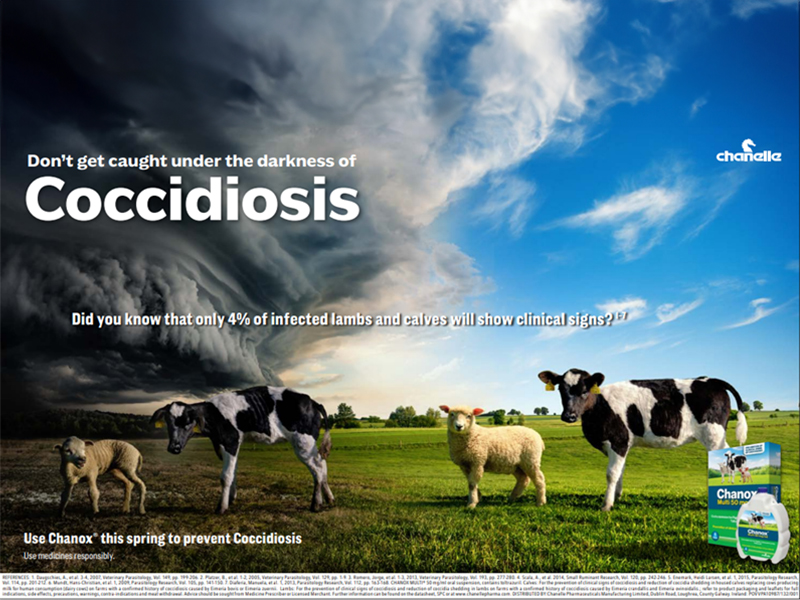John Kingham, Ireland’s largest suckler farmer based in Dundalk Co. Louth, has had fantastic success in preventing coccidiosis in his herd.
He has set the benchmark for suckler farming in Ireland, with his impressive 500 suckler cow farm known as ‘Tateera and Rathmore’ farm.
As the largest suckler farm in the country, Kingham’s operation has become synonymous with quality and excellence.
John calves 500 cows on 1000ac, aiming to sell calves under a year old. In 2023 the average weight at sale was 420kg, with an average price of just over €1,900.
Running a mixed system between spring and autumn calving, John’s farming enterprise is bolstered by a team of three full-time staff members.

The effects of coccidosis
Coccidosis is a disease caused by protozoan parasites of the genus eimeria, which are typically numerous in livestock environments.
Animals readily consume coccidia oocysts when grazing or simply exploring their surroundings.
Coccidia oocysts ingested by the animal, travel through the digestive system and arrive in the animal’s gut.
Here they penetrate the cells in the lining of the gut and undergo multiple stages of multiplication.
Towards the end of a three-week lifecycle, these cells rupture, damaging the gut lining and leading to the characteristic dark/bloody scour.
Infected animals excrete large amounts of new oocysts in their faeces, once the lifecycle completes, becoming a significant source of infection for other animals in their vicinity.
As the gut lining is responsible for nutrient absorption, a damaged gut can lead to considerable production losses from malabsorption and clinical disease.
Coccidiosis symptoms
Clinical signs of coccidiosis might be seen in calves up to six-months-of-age and lambs up to eight-weeks-of-age. Some of these symptoms include:
- Bloody/black diarrhoea;
- Fluid loss;
- Lack of appetite;
- Lethargic animals;
- Fever;
- Death.
Young animals are at risk from coccidiosis, as they have not yet built up an immunity to the parasite.

However, the percentage of animals in an infected group with clinical symptoms is typically low.
Although there may be no clinical signs showing in the animal, they may be suffering from subclinical disease, as their immune system consumes large amounts of energy fighting the parasite and as such, growth and performance is likely to be reduced.
Considering the large scale of his production, John cannot afford any setbacks, as his calves need to meet their targets for sales: “We simply cannot afford any setbacks, as we aim to sell all our offspring before yearlings, all animals are treated at 7 weeks of age with Chanox as a preventative.”
Measures carried out on Tateera and Rathmore farms to prevent coccidiosis:
- Regularly changing the bedding prevents the accumulation of bacteria, parasites and pathogens that could potentially harm the animals. John said: “We practice good hygiene by avoiding wet bedding and regularly cleaning the sheds.”
- Choosing to elevate the water troughs reduces the risk of contamination and coccidia transmission;
- By clipping the cows’ tails in advance of calving, it significantly reduces the amount of faecal matter that can adhere to the tails, minimizing the transfer of contaminants to the udder and reducing the risk of coccidia infection;
- Treat calves with anti-coccidial at seven weeks-of-age.

The solution
Anti-coccidials are agents that disrupt the coccidia life cycle. Products like Chanox, if administered at the correct time, reduce both potential damage to the animal’s gut and contamination of the animal’s environment.
Kingham has been successfully using Chanox for the past six years on his 500 suckler cow farm to prevent coccidiosis in his calves.
This preventative measure has effectively eliminated any issues with coccidiosis on his farm during this period.
He said: “We have recorded no outbreak of coccidiosis in the past six years since using Chanox.”
In seven studies discussed below, the liveweights of animals were monitored. During the experiment, half of the animals were treated with an anticoccidial.
Across all the studies, it was found that animals treated with anticoccidials exhibited an average performance increase of 19% – over the averaged 42-day trial period.
“I am thrilled by what Chanox has accomplished for us here. The calves never look back once dosed, and there is a great sense of reassurance that we are preventing coccidiosis,” he stressed.

Sub-clinical coccidiosis
When a disease affects an animal without pronounced symptoms, its form is referred to as ‘sub-clinical’.
All ruminants kept under conventional conditions unavoidably experience infection with coccidia at some point.
Sub-clinical coccidiosis can be more economically damaging to a farm than clinical cases, as there may be no sign of infection, yet performance will have reduced in peer reviewed research.
The effect of coccidiosis infection has been shown to reduce full groups’ average weight gain by 19%.
Yet, in the same trials, only one in 25 animals exhibited coccidiosis symptoms. That is why it is important to treat coccidiosis as a group problem, and avoid focusing on individual cases.
For more information, please click here.

